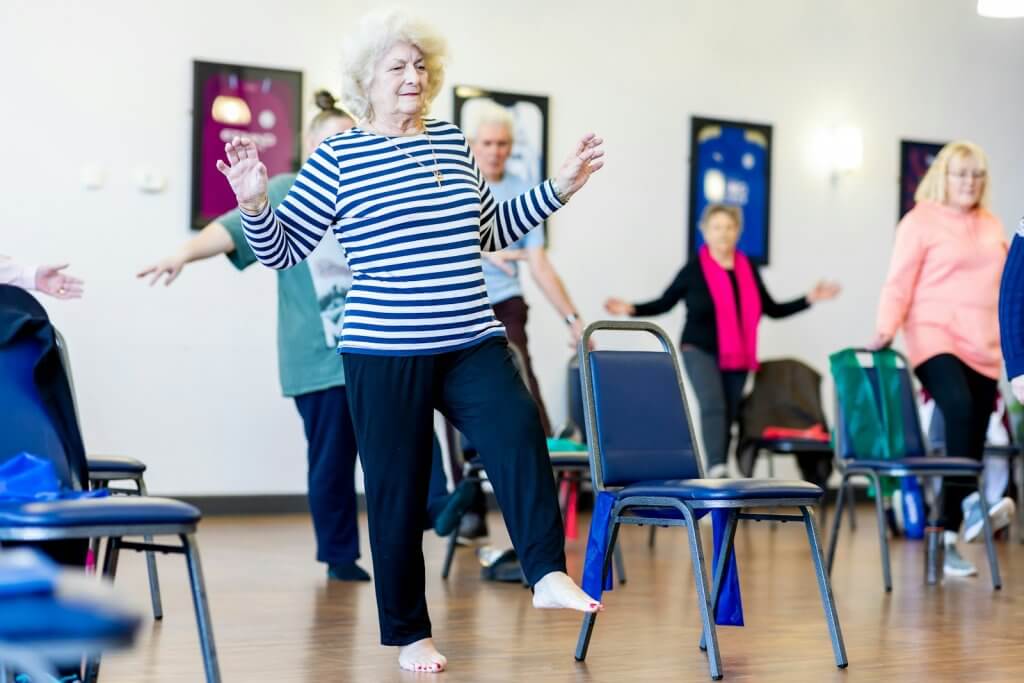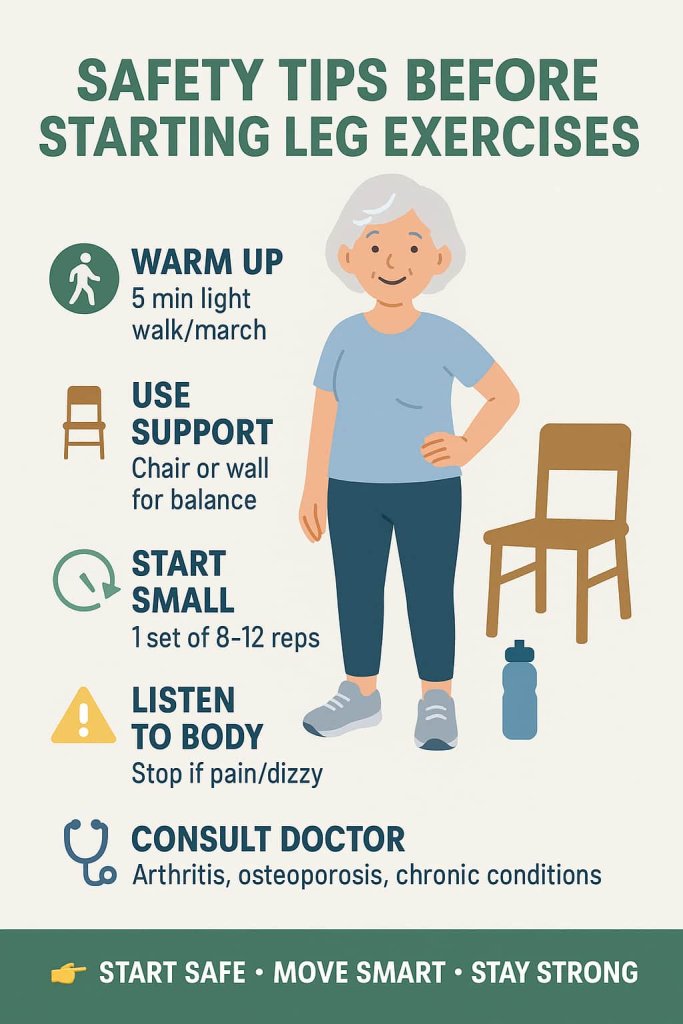The best leg strengthening exercises for seniors are safe, joint-friendly, and highly effective at improving mobility, balance, and independence. Strong legs are vital for walking, standing, climbing stairs, and preventing falls as we age.

Research shows that resistance training in older adults significantly improves muscle strength, bone health, and reduces fall risk (Journal of Strength & Conditioning Research, 2019). By practicing simple, low-impact exercises regularly, seniors can maintain independence, protect joints, and live more confidently.
This guide covers 12 safe and effective leg strengthening exercises for seniors—with step-by-step instructions, benefits, and trainer tips.
Why Leg Strengthening Is Important for Seniors

- Fall Prevention: Stronger legs improve stability and reduce fall risk.
- Mobility Support: Easier walking, stair climbing, and daily activities.
- Joint Protection: Leg muscles support knees, hips, and lower back.
- Independence: Greater confidence in movement and self-care.
👉 According to a 2020 study in the International Journal of Behavioral Nutrition and Physical Activity, combining strength and balance training reduces fall risk by nearly 30% in older adults.
Safety Tips Before Starting

- Warm up with 5 minutes of light walking or marching in place.
- Use a sturdy chair or wall for balance support.
- Start with 1 set of 8–12 reps, progress gradually.
- Stop if you feel sharp pain, dizziness, or shortness of breath.
- Consult your doctor if you have arthritis, osteoporosis, or chronic conditions.
12 Best Leg Exercises for Seniors
Strong legs are the foundation of mobility, balance, and independence as we age. Leg strengthening exercises for seniors improve walking, reduce fall risk, and support daily activities like climbing stairs or standing up from a chair. These movements are safe, low-impact, and can be adapted to any fitness level.
Below are 12 of the best exercises, complete with benefits, instructions, and trainer tips.
1. Sit-to-Stand (Chair Squats)
Muscles worked: Glutes, quadriceps, hamstrings.
Why it helps: This simple move mimics standing from a chair—an essential daily activity. It strengthens the lower body while boosting independence.
How to do it:
- Sit on a sturdy chair with feet flat on the ground.
- Lean forward slightly, push through heels, and rise to standing.
- Slowly lower back down under control.
Trainer Tip: Use the chair’s armrests if needed for extra support.
Reps/Sets: 8–12 reps, 2–3 sets.
2. Standing Calf Raises
Muscles worked: Calves, ankle stabilizers.
Why it helps: Strengthens calves and ankles, which are critical for walking stability and preventing trips.
How to do it:
- Stand tall, holding the back of a chair for balance.
- Lift heels off the floor to stand on your toes.
- Lower slowly back down.
Trainer Tip: Pause for 2 seconds at the top for better calf activation.
Reps/Sets: 10–15 reps, 2 sets.
3. Step-Ups (Low Step or Stair)
Muscles worked: Quads, glutes, calves.
Why it helps: Builds strength for climbing stairs, curbs, and uneven terrain.
How to do it:
- Stand in front of a sturdy step or low stair.
- Step up with one foot, then bring the other foot up.
- Step down carefully and repeat.
Trainer Tip: Hold onto a railing if balance is uncertain.
Reps/Sets: 8–10 per leg, 2 sets.
4. Side Leg Raises (Hip Abduction)
Muscles worked: Gluteus medius, hip stabilizers.
Why it helps: Strengthens side hip muscles that support balance and prevent falls.
How to do it:
- Stand tall while holding onto a chair.
- Slowly lift one leg out to the side.
- Lower back down with control.
Trainer Tip: Keep torso upright—avoid leaning sideways.
Reps/Sets: 8–12 per leg, 2 sets.
5. Seated Leg Extensions
Muscles worked: Quadriceps.
Why it helps: Improves thigh strength for walking and standing from a seated position.
How to do it:
- Sit tall in a chair, feet flat.
- Extend one leg forward until straight.
- Hold for 2 seconds, then lower.
Trainer Tip: Add ankle weights when ready for more challenge.
Reps/Sets: 8–12 per leg, 2 sets.
6. Standing Hip Extensions
Muscles worked: Glutes, hamstrings.
Why it helps: Strengthens the backside muscles, aiding posture and walking power.
How to do it:
- Hold onto a chair for balance.
- Extend one leg straight back without arching your lower back.
- Return to start.
Trainer Tip: Focus on squeezing glutes instead of swinging your leg.
Reps/Sets: 8–12 per leg, 2 sets.
7. Heel Slides (Floor or Bed)
Muscles worked: Hamstrings, quads.
Why it helps: Gentle exercise that maintains flexibility and mobility in the knees.
How to do it:
- Lie on your back with knees bent.
- Slowly slide one heel forward to straighten the leg.
- Slide it back to the start position.
Trainer Tip: Wear socks for smoother movement.
Reps/Sets: 10–12 per leg, 2 sets.
8. Mini Lunges
Muscles worked: Quads, glutes, calves.
Why it helps: Improves balance and builds functional strength for daily steps and bending.
How to do it:
- Stand tall and step forward slightly.
- Bend both knees gently to lower your body.
- Push back to standing.
Trainer Tip: Keep movements shallow for joint safety.
Reps/Sets: 6–8 per side, 1–2 sets.
9. Wall Squats (Partial)
Muscles worked: Quads, glutes.
Why it helps: Builds leg endurance while protecting the knees.
How to do it:
- Stand with your back against a wall.
- Slowly slide down a few inches.
- Hold for 5 seconds, then rise back up.
Trainer Tip: Don’t go too low—stay within comfort.
Reps/Sets: 6–10 reps, 2 sets.
10. Seated Marching
Muscles worked: Hip flexors, quadriceps.
Why it helps: Improves hip strength and mobility for walking and climbing stairs.
How to do it:
- Sit tall in a chair.
- Lift one knee toward your chest.
- Lower and switch legs.
Trainer Tip: Lift knees slowly to work the muscles more effectively.
Reps/Sets: 10–15 per side, 2 sets.
11. Glute Bridges
Muscles worked: Glutes, hamstrings, core.
Why it helps: Strengthens hips and core, helping with stability and lower-back support.
How to do it:
- Lie on your back with knees bent and feet flat.
- Push through your heels to lift your hips.
- Hold for 2–3 seconds, then lower.
Trainer Tip: Keep shoulders relaxed and avoid arching your lower back.
Reps/Sets: 8–12 reps, 2 sets.
12. Ankle Circles (Mobility & Strength)
Muscles worked: Calves, ankle stabilizers.
Why it helps: Boosts circulation, mobility, and ankle strength—important for balance.
How to do it:
- Sit tall and lift one foot slightly off the floor.
- Rotate the ankle clockwise 5–10 times.
- Switch direction.
Trainer Tip: A great warm-up or cool-down movement.
Reps/Sets: 5–10 circles each way per ankle.
Who Should Avoid Leg Strengthening Exercises?
While most seniors benefit, some should exercise caution:
- Those with severe osteoporosis or recent fractures.
- Individuals recovering from hip/knee surgery (need doctor’s clearance).
- People with uncontrolled hypertension or heart issues.
- Seniors with serious balance problems without supervision/support.
👉 Always consult a healthcare provider before beginning if you have chronic conditions.
How to Start a Leg Exercise Routine as a Senior
- Warm Up (5 minutes): Light walk or arm circles.
- Pick 3–4 Moves: Chair squats, calf raises, seated marches, glute bridges.
- Start Small: 1 set of 8–10 reps, 2–3 times per week.
- Progress Gradually: Add more reps or sets every 2–3 weeks.
- Track Progress: Note improvements in walking, standing, or reduced pain.
Programming Tips
- Frequency: 2–3 days per week, non-consecutive.
- Progression: Add reps, sets, or use resistance bands.
- Balance Pairing: Combine with standing balance drills.
- Monitoring: Use a notebook or app to track consistency.
Lifestyle Tips to Keep Legs Strong Beyond Exercise
- Nutrition: Eat protein-rich foods (lean meat, eggs, beans) + calcium & vitamin D for bone health.
- Daily Movement: Take stairs, short walks, or stand up every hour.
- Flexibility: Stretch hamstrings and calves regularly.
- Hydration: Drink enough water to support joint health.
- Sleep & Recovery: Rest days are just as important as workouts.
FAQs About Leg Strengthening for Seniors
1. How often should seniors train their legs?
2–3 times per week, with rest days in between.
2. Are resistance bands safe for older adults?
Yes, they add gentle resistance without heavy joint stress.
3. How long before results show?
Most notice improvements within 6–8 weeks of consistency.
4. Do these exercises also help balance?
Yes, stronger legs improve stability and reduce fall risk.
5. What if I have knee arthritis?
Choose low-impact moves like seated leg extensions and heel slides.
6. Should I stop if I feel sore?
Mild soreness is normal; sharp pain is not. Stop and rest if needed.
Conclusion
Leg strength is the foundation of mobility, independence, and fall prevention in seniors. By practicing these 12 safe and effective exercises, older adults can move more confidently, protect their joints, and enjoy an active lifestyle.
👉 Start slow, stay consistent, and celebrate every improvement—because strong legs mean a stronger life.
